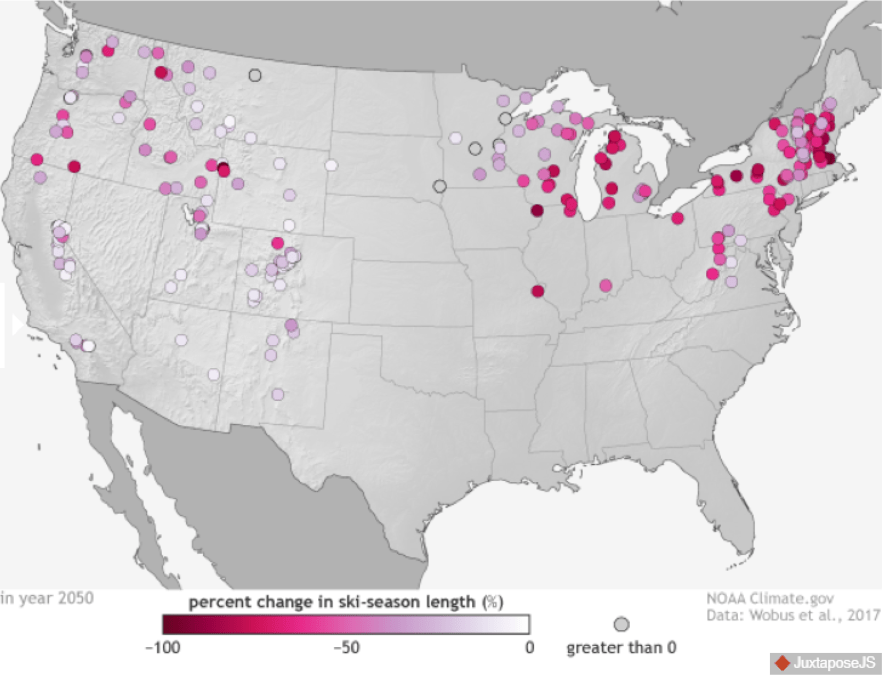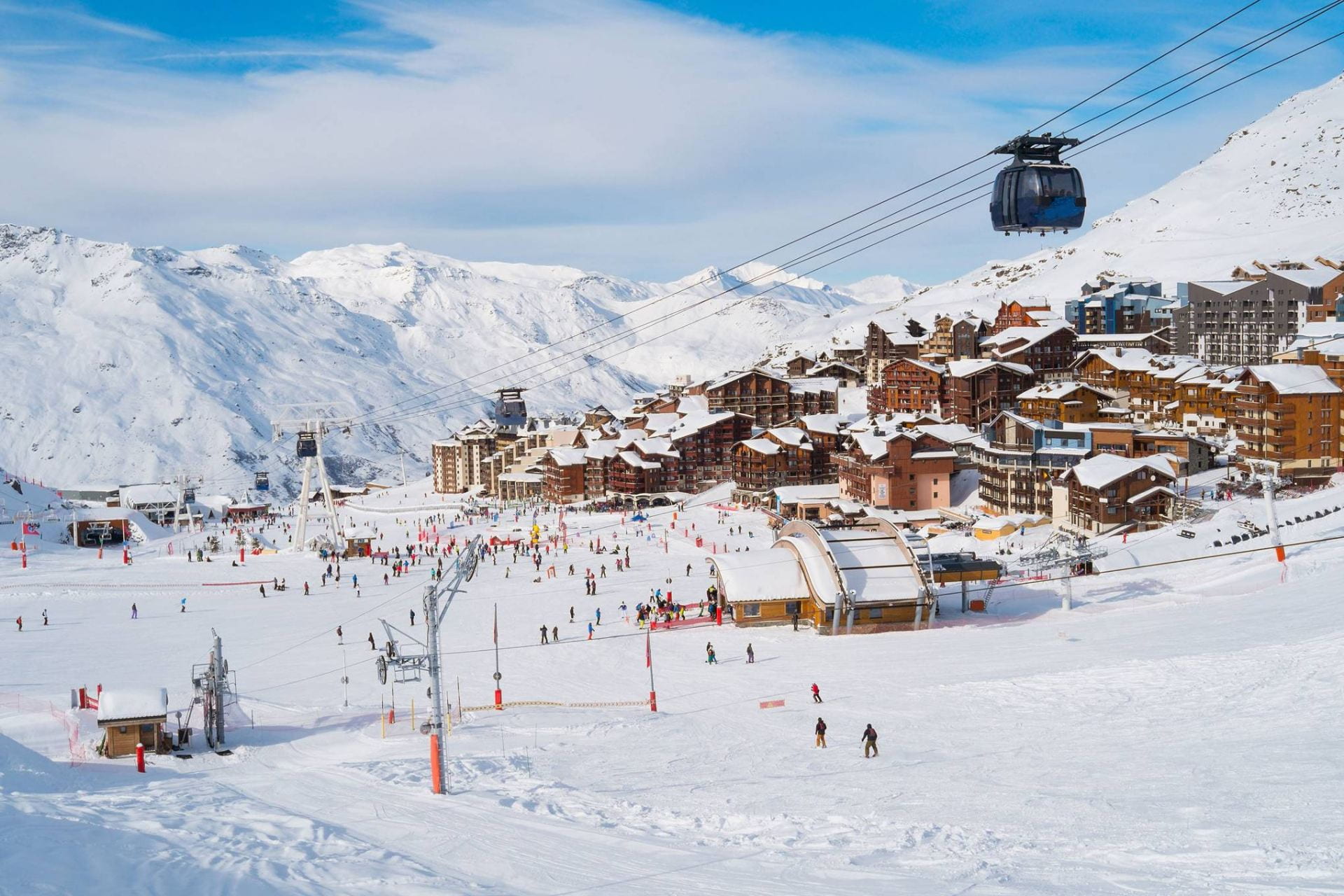Vail Resorts, Inc. is one of the world’s best-known ski resort operators and US’ largest. The company works across different segments, including the operation of 12 mountain and 3 urban ski resorts (in US, Canada and Australia), owning and managing a collection of luxury hotels and developing real estate around their winter resorts. However, their business model is under serious threat.
In the last 200 years, the earth has warmed 1.4 degrees Fahrenheit and if greenhouse gas emissions continue to rise, snowfall, winter and skiing will no longer exist as we know them by 2100. Because of warmer winters, more than half of the ski resorts in the US may no longer exist in 30 years. The ski season has been already shortened by 34 days while predictions indicate a total season length of less than two months by 2050. Besides, shortened seasons means missing Christmas holiday period, and international winter sport hosting opportunities which can be a business killer. Furthermore, current artificial snow technologies remain costly.

It is time for action and Vail Resorts has decided to lead by example, taking a deep dive into sustainability and environmental issues in order to show how the industry can get greener and offset as much as possible the impacts of bringing large numbers of travelers into the mountain environment.
Action time
Vail Resorts, which signed the “We are still in” letter to President Trump when the USA left the Paris Climate Agreement, has taken an active position against global warming with its EPIC Promise Commitment to Zero initiative, launched in July 2017. The Promise focuses on three challenges:

- Zero Net Emissions by 2030 (eliminating the carbon footprint) by:
- Reducing electricity and natural gas use by another 15%, in addition to the previously achieved 19%, by improving operating practices and investing into innovative, energy-saving projects (low-energy snowmaking equipment, green building design and construction, etc).
- Purchasing 100% renewable energy that is equivalent to its total electrical energy use. Vail Resorts is the second largest buyer of renewable energy in North America and is a member of Ceres Business for Innovative Climate and Energy Policy, as well as RE100 – a global collaborative initiative of influential companies committed to using 100% renewable electricity.
- Investing in carbon offset programs such as tree planting, to account for use of fossil fuels.
- Engaging with vendors and suppliers to identify and collaborate on opportunities to reduce their emissions and environmental impact.
- Zero Waste to Landfill by 2030:
Vail Resorts will divert 100% of the waste from operations to more sustainable pathways by 2030. Currently, the rate stands at 40%. The company is:
- Improving the recycling and composting program.
- Engaging with vendors to reduce packaging as well as to source recyclable and compostable products.
- Working with local resort communities to increase options of reuse and diversion.
- Increasing awareness and engagement with employees and guests through signage, labelling and training.
- Zero Operating Impact on Forests and Habitat:
Managing the health and resilience of forests and habitat takes long-term planning. To protect the environment it operates in, Vail Resorts is committed to:
- Minimizing or eliminating the impact of any future resort development.
- Planting or restoring every acre of forest displaced by operations.
- Continuing and expanding existing commitments to partner with and fund local organizations focused on the health of forests, habitat and wildlife.
Even though the EPIC Promise has set some ambitious goals for 2030, Vail Resorts remains vulnerable to the actions of other companies and countries, which aren’t going green immediately. It has therefore been investing in backup plans. The first idea to hedge the risks of global warming was to extend the activities offer to the summer season. The company has invested a lot to grow its revenues during summertime, from hiking trails and family activities to new hotels. However, the summer season will never make up for the potential losses due to reduced ski seasons.
Vail Resorts have also launched the EPICpass, a seasonal ski pass that gives unlimited access to the company’s 15 resorts, allowing passholders to choose their holiday destination according to snowfall forecasts. Holiday-goers don’t get locked in a specific ski resort and get rid of the risk of not having any snow. This pass helps Vail Resorts keep the retention to a profitable level.
Finally, the firm’s last effort to ensure future revenues came in 2016, when they bought the Canadian resort of Whistler BlackComb for $1.06 billion, the biggest on the American continent with over 33 skiable km². Its location up North means a lengthier ski season decreasing the need for snow guns.
Additional actions to consider
Further initiatives that Vail Resorts could do in different areas are:
Reduction of waste:
- Minimise the food waste from the restaurants in the ski stations. Either implementing technologies as Winnow Solutions or offering a discount on prepared meals that otherwise will be wasted.
- Removal of the ski pass card. Most of them are only used daily or for few days. This will reduce the plastic / paper usage. Instead a simple app or electronic pass via your phone could be used.
Reduction of Impact:
- Artificial snow is still a heavy producer of GHG and uses plenty of water. Vail Resorts could invest in R&D to find even more sustainable technologies and reduce the environmental impact.
- Work closely with ski material and ski clothing companies, in order to ensure the use of recycled materials, minimize the environmental impact through manufacturing and supply chain, and share sustainable goals. In this case, a partnership with Patagonia could be done, offering discounts to customers and Vail Resorts employees to purchase its products while at the same time raise awareness.
New business opportunities:
- Summer time activities could be expanded, to mountain biking, via ferrata, and climbing. In all these activities there is the need of renting /buying material and potentially the need for an instructor. Also, gym classes in the nature could be offered as a summer activity.
Mireia García Casas, Olaf Boullé, Pablo López Bouzas, Charbel El Helou (MBA19D)
List of sources:
https://www.vail.com/the-mountain/more-options/sustainability.aspx
https://www.powder.com/stories/climate-change/vail-announces-plan-zero-net-footprint-2030/
https://www.nytimes.com/2014/02/08/opinion/sunday/the-end-of-snow.html

My initial thought as I was reading this was about the “fake snow” machines they use for supplementing the natural snow. This allows them to extend the season somewhat but makes the actual skiing very uncomfortable and potentially more unsafe (in my experience). So it’s interesting that you pointed out how these “fake snow” machines actually use a ton of water and produce GHG – things that make the environment even worse. I wonder if they really can come up with some kind of alternative for this.
I really like the initiative proposed by Vail Resorts. Even thought they know they won’t revert the situation in enough time to keep their ski business sustainable, they show they care about the environment and are not only interested in their own gain and profits. I think business such as this one need to quickly find other ways to keep themselves sustainable so change of focus to summer holidays is a great move, by offering hikes in the mountains for example, they can still use their current infrastructure to provide a service that certainly will have demand. They know they are not the only ones in the industry affected by the climate change and changing their business to a more environmental friendly won’t be enough to revert the situation, this is in the hands of other industries, so exploring new business models is the best bet.
I am pleased that someone wrote about this topic. Since I was a little girl, I spend as much time as possible on my beloved Alps in Italy, where I was born. In 2012 I started to do mountaineering and in 2014 Ski-mountaineering. Often climbing up in the mountains, you can see the lines that have been drawn where the glacier used to be and the indication of the year. Everybody can clearly see how ice is quickly melting, and we’re losing hundreds of meters of ice every ten years. I do think that the economic interests that Ski resorts carry are a significant push to move towards a more eco-friendly approach, especially in the mountains. Thanks for sharing what Vail is implementing. I hope that many others will follow the lead!
Thanks for the post! I couldn’t help but wonder that most of these industries affected by climate change have been big contributors themselves in the past. It’s really commendable that they are making efforts to be sustainable even though they know that snow isn’t coming back, however, from what I remember, ski resorts have been quite notorious in the past for deforestation in order to clear land for pistes. Just last year, one of the Canadian resorts was in news for clearing land higher up in mountains endangering wildlife population there. More unfortunate was that a deal was made for them to “invest” somewhere else in the region to protect lynx population :/